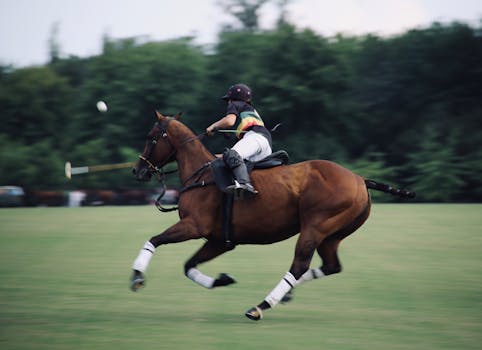Polo: A Team Sport on Horses
Polo is a thrilling and dynamic team sport that combines the elegance of horseback riding with the strategic elements of team play. Originating in Persia over 2,500 years ago, polo has evolved into a popular sport played worldwide, particularly in countries like Argentina, the United States, and the United Kingdom. This article delves into the techniques, rules, and the critical importance of team communication in polo, providing insights for both enthusiasts and newcomers to the sport.
Understanding the Basics of Polo
Polo is played on a large grass field, typically measuring 300 by 160 yards, with two teams of four players each. The objective is to score goals by hitting a small ball through the opposing team’s goalposts using a long-handled mallet. The game is divided into periods called chukkas, each lasting seven minutes, with a match usually consisting of four to six chukkas.
Key Techniques in Polo
Mastering polo requires a combination of riding skills, mallet techniques, and strategic thinking. Here are some essential techniques that players must develop:
- Riding Skills: Players must be adept at controlling their horses, known as ponies, which are specially trained for the sport. This includes understanding how to maneuver quickly and maintain balance while executing shots.
- Mallet Control: Effective use of the mallet is crucial. Players need to learn how to strike the ball accurately while maintaining control over their horse. This involves practicing different types of shots, such as forehand, backhand, and neck shots.
- Positioning: Understanding where to position oneself on the field is vital. Players must anticipate the ball’s movement and their teammates’ actions to create scoring opportunities.
Rules of Polo
The rules of polo are designed to ensure fair play and safety for both players and horses. Here are some fundamental rules:
- Fouls: Players must avoid dangerous play, such as riding into another player or hitting the ball from an unsafe position. Fouls can result in free hits for the opposing team.
- Right of Way: The player with the ball has the right of way, and other players must avoid interfering with their path. This rule is crucial for maintaining safety on the field.
- Scoring: A goal is scored when the ball passes between the goalposts. The team with the most goals at the end of the match wins.
Importance of Team Communication
In polo, effective communication among team members is paramount. Unlike many sports where players can rely on individual skills, polo is inherently a team-oriented game. Here’s why communication is essential:
- Strategic Play: Teams must develop strategies that involve coordinated movements and plays. Clear communication helps players understand their roles and responsibilities during the game.
- Anticipation: Players need to anticipate each other’s actions. By communicating effectively, they can predict movements and make split-second decisions that can lead to scoring opportunities.
- Safety: Given the speed and physical nature of polo, communicating about positioning and potential hazards is crucial for the safety of both players and horses.
Case Studies and Examples
Several professional polo teams exemplify the importance of communication and teamwork. For instance, the Argentine team La Dolfina, led by the renowned player Adolfo Cambiaso, has dominated the sport for years. Their success can be attributed not only to individual talent but also to their seamless communication and understanding on the field. They often practice specific plays and strategies, ensuring that each player knows their role during a match.
Statistics also highlight the significance of teamwork in polo. A study conducted by the Polo Players Association found that teams with higher communication scores during practice sessions had a 30% higher win rate in competitive matches. This underscores the idea that effective communication can be a game-changer in high-stakes situations.
Conclusion
Polo is more than just a sport; it is a complex interplay of skill, strategy, and teamwork. Understanding the techniques and rules is essential for any player, but the importance of communication cannot be overstated. As players develop their skills and learn to work together, they not only enhance their performance but also contribute to the rich tradition of this exhilarating sport. Whether you are a seasoned player or a newcomer, embracing the principles of teamwork and communication will undoubtedly elevate your polo experience.
